How to Avoid, Find, Get Rid of Bed Bugs, and Prevent Re-Infestations
More than 300 people have attended the second National Bedbug Summit in Washington DC in February 2011, to find solutions to a growing problem, made worse by ineffective control measures and growing resistance of the buds to pesticides.
Experts now claim that bedbug infestations are becoming more widespread and bed bugs have become perhaps the toughest pest to control and get rid of in hotels and domestic accommodation. The insects are becoming more resistant to chemical insecticides and other treatments and can be quickly spread in customers luggage.
The summit in Washington DC was hosted by US Environmental Protection Agency (EPA), and included many government agencies and industry representative. Recent surveys and similar conferences recently have shown that the problem is getting worse and is causing widespread concern in the travel and accommodation industries.
Official national statistics on the numbers of bedbug infestations in the US, show that the number of cases is rising alarmingly, and more resources are being put into the problem. Infestations are spreading like wildfire both in terms of the number of locations within a community infected, and the number of suburbs, towns and cities showing outbreaks. While most cases in the US are in cities on the East Coast, there are now reports of infestations in virtually every state in America.
This article summarizes the nature and scope of the problem and discusses ways to deal with it more efficiently. Below is a summary of the current advice.



How to Detect Bed Bugs
Identifying a bed bug - Cimicidae (or bed bugs), are small insects that feed exclusively on blood. The most common species is Cimex lectularius. Bed bugs are quite flat and resemble a small pear shaped beetle or roach. Adults are small, about the size of an apple seed and nymphs can be as small as pin heads. Adults grow to about 4–5 mm in length (3/16 inch) and about 1.5–3 mm in width. The adults are reddish brown in color with nymphs being yellowish to clear. After feeding both adults and nymphs develop a reddish glow as they become engorged with blood. Bedbugs can survive an extraordinary range of temperatures. Below 16.1 °C (61.0 °F), adults enter semi-hibernation. Bedbugs can survive for at least five days at -10 °C (14.0 °F). They are highly tolerant to desiccation and harsh conditions. The high-temperature death point for the common species is very high at 45 °C (113 °F). All of the life stages are killed after 7 minutes at 46 °C (115 °F).
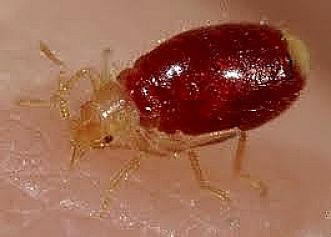
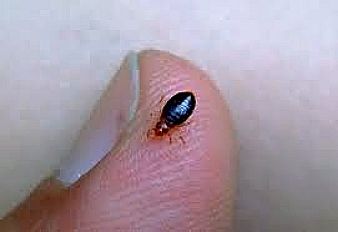


Bedbugs are obligatory blood feeding parasites that are attracted to their hosts primarily by the carbon dioxide in exhaled breath, and secondarily by heat, and they also use certain chemical cues. A bedbug uses two hollow tubes shaped like tongues to pierce the skin of its host. One tube is used to injects its saliva, which contains both anaesthetics and anticoagulants. The other tube is used to withdraw the blood. After sucking blood for about 5 minutes, the bug moves off and returns to its hiding place.
It generally takes between 5 and 10 minutes for a bedbug to become fully engorged with blood. Although bedbugs can survive for about a year without feeding, they generally need a feed of blood every 5 to 10 days under most conditions. In colder climates, bedbugs can live for about 12 months; and in milder temperatures about 5 to 6 months.
Check for bites - If you have bites this is a clear sign that you have them, however many people can be bitten without showing any signs, and so tbites can be unreliable. Bed bug bites look very similar to mosquito bites, and often occur on the arms, back or legs. One unique feature of bed bug bites is that the bites often occur in rows, with three or four bites in a line.
Check the Registry - As for checking to see whether your hotel has had reports of bedbugs, see Bedbug Registry, and Bedbug Database and other sites. Travelers should also check for reports of bed bugs or infestations before checking into any hotel or motel by going to Trip Advisorand other similar sites. However this can be quite unreliable. You don't know whether the information is up to date or is reliable and complete for your area.
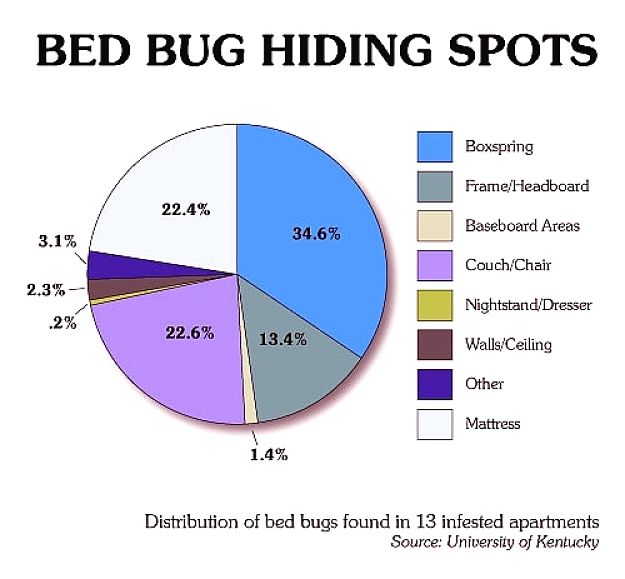
Check for Signs - Use a flashlight when you travel to inspect the hotel room, or to inspect you own room at home. Inspect all the areas listed below methodically and carefully.
- Search for faecal spotting (little black spots) on the mattress or box spring, pillow seams, around the headboard, seams in the mattress and on the wall next to your bed.
- Thoroughly check the box spring, including the underside – the most common hiding place for bed bugs.This is a favourite place for bed bugs as it is close to its blood meal (you) and is an undisturbed and well hidden location on the bed.
- Look in all the cracks and crevices near the bed. This means on the floor, walls and ceiling. Check behind hanging pictures, behind and under dressers, under chair cushions, around and inside electrical outlets, around mirrors, along floorboards and along the wall and floor joints.
- Check around clutter on the floors, closets, bookshelves, etc.which are are all good hiding places.
- It is generally quite rare to see blood, but look for that as well.
- Also familiarize yourself with what bedbugs look like, as they can be visible. When you wake up during the night use the flashlight to check your body for bed bugs.
Bed bugs are a nocturnal and come out at night and drink blood from human and also other hosts like pets. The bugs will track you down from the carbon dioxide you exhale and body heat. They will generally be found quite close to where you sleep.
Trap them - While trapping bed bugs won't work as an eradication method, it can help to identify the problem very quickly, and to check for reinfestations. Take strips of double sided sticky tape and attach them to the box spring, the edges of the mattress, and on the floor next to the bed. Then check again after four to seven days. If bed bugs are present you should catch them.
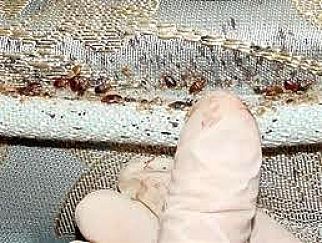
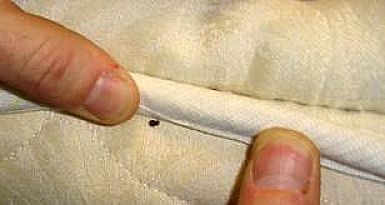
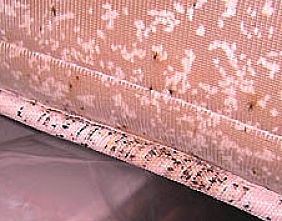
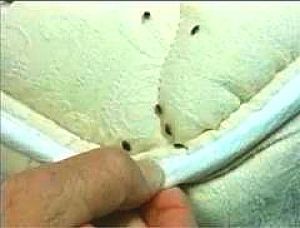
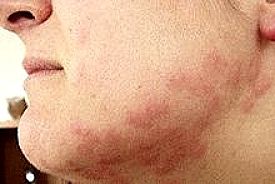

How to Avoid Getting Bed Bugs in Your Home or Apartment
- Bed bug love to hitch a ride on your clothing, so protect clothing and luggage against bedbugs when you travel
- Protect your bedding with quality bedding protection products
- Protect your clothing with laundry bags
- Protect yourself when you travel with suitcase protectors and travel pillow protectors
- Avoid carrying bugs home with you - unpack outside if you can and treat any clothes.
- Seal clothing in either a biodegradable bag that dissolves in the washer or in a sealed plastic bag.
- Put clothing in the washer and dryer at high heat immediately upon your return.
- Strip down and remove your travelling clothes in a private area outside or in a bathtub, immediately you return - do not put them onto the bed or floor. Again, put clothes right into the washer.
- Always keep your suitcases and travelling bags outside of the house (in a shed or garage) in a sealed plastic container. You can get portable heating units that can be used to treat suitcases and kill off the bugs. Also, you can treat suitcases with pest strips and seal them up in a plastic bag. Or put a bag in the dryer if it can withstand heat.
- Don't take in second-hand beds or mattresses
- Don't allow things to build up close to where you sleep.
- Don't wait to report a problem - if you suspect an infestation deal with it immediately before it grows. Call pest control to deal with an infestation. Tell the hotel about it.
- Travelers can take precautions by using mattress and travel liners that protect from bed bugs.
How to Get Rid of Bedbugs in Your Home
The best advice is to call an experienced a bed bug Pest Management Professional IMMEDIATELY. There are many ways that you can get rid of bed bugs but usually using an exterminator is the best way to go.
- Immediately after the bed bug infestation has been treated and eradicated, protect your bedding from re-infection. You may want to consider SecureSleep protection and encasement products, or other similar products. You will need to establish a management plan to prevent re-infestation. There may be pockets of remnant infestations that may he been missed in suitcases or clothes.
- DIY treatments such as home chemicals and "foggers" - bug bombs - should be used with caution.
- Follow an integrated pest management (IPM) approach that includes a multifaceted strategy, such as preventive measures (prevention is better than treatment), thorough sanitation, and the use of chemicals applied to targeted sites. Experienced pest control companies know where to look for bed bugs, and they have many IPM management tools and strategies that can be applied. It is important that the treatment is applied beyond the bedroom, as other rooms may be infested, such as the hall cupboards where suitcases are stored. Owners and occupants will need to help the professional in many ways.
- Wash (120°F, 46°C minimum) or discard bedding, pillows or garments, because these items cannot be treated with insecticides. Many smaller items that cannot be washed can be sanitized by heating. Wrap other individual items in plastic and place them in a hot, sunny location for a day or so (check the temperatures rise above 120°F). Trying to treat an entire home or apartment by raising or lowering the internal temperature will not work as many areas whether the bugs occur may remain insulated. Similarly, insecticide 'Bombs' will not work because the bugs hide in nooks and crannies where the insecticide won't penetrate.
- Vacuum the vulnerable rooms in the house to remove eggs and live bugs from mattresses, walls, floors, carpets, and other surfaces. Focus particularly on the seams, tufts and all along the edges an surfaces of box springs and mattresses, including the underside. Also pay particular attention to the outer perimeter of wall-to-wall carpets, along the walls. Always dispose of the vacuumed material in a sealed trash bag, and clean the vacuum cleaner itself. Steam cleaning of carpets is also an excellent idea for killing bugs and eggs that you may have missed with simple vacuuming.
- Repair all cracks in plaster, loose paint and glue down any loose wallpaper to eliminate bug hiding sites.
- Use residual insecticides (such as pyrethroids) as spot treatments applied to, corners, cracks and crevices where bed bugs may be hiding. However these treatments are best done by a professional. Follow-up treatments may be required at two weeks intervals and a thorough treatment of all areas in the house needs to be completed - not just the mattresses in the bedrooms.
Non-Chemical Treatment Methods for Bed Bugs
- Get a bedbug mattress protector and leave it on for at lest 12 months because bedbugs that don't feed will go into survival mode, and can hibernate for at least one year.
- Pull apart your bed frame and thoroughly clean and vacuum it. This must be carried out perfectly. It may take an hour or two but it will save you time money and grief.
- Vacuum the floors of the bedroom, edges and walls thoroughly.
- Take all the bedding off the bed and run in the dryer for at least thirty minutes on a high heat to kill the bugs and their eggs.
- Relocate your forensically cleaned bed and mattress at least half a metre away from the bedroom walls and furnishings.
- Remove all stored materials from under bed, shoes and cloths etc. But do not remove the items from the bedroom at this stage because you may risk spreading the bedbugs throughout the house. Store the materials in sealed bags with pesticide strips until they can be removed safely. The removed materials must be stored one metre away from bedhead.
- Wrap your bed legs in plastic or gladwrap so they are waterproof.
- Place your bed legs in bowls and silicon the legs to the bottom of the bowls. Fill the bowls with water and this will provide a barrier.
- Use double-sided tape as traps to see whether bed bugs are still trying to re-infest your bed.